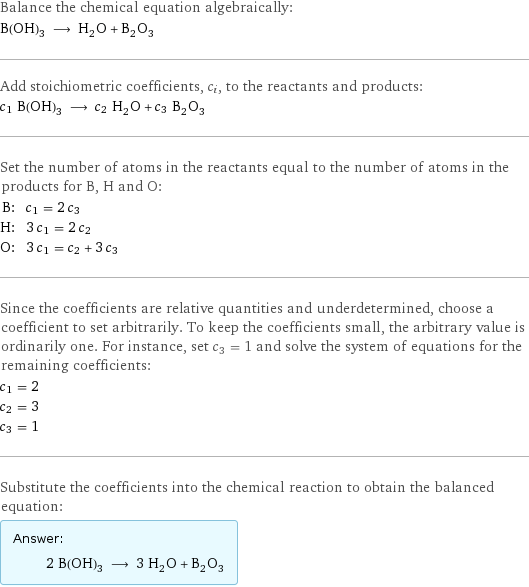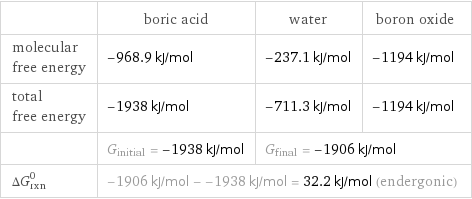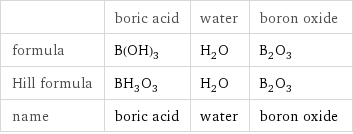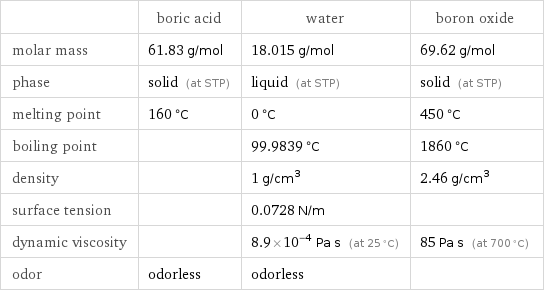Input interpretation

B(OH)_3 boric acid ⟶ H_2O water + B_2O_3 boron oxide
Balanced equation

Balance the chemical equation algebraically: B(OH)_3 ⟶ H_2O + B_2O_3 Add stoichiometric coefficients, c_i, to the reactants and products: c_1 B(OH)_3 ⟶ c_2 H_2O + c_3 B_2O_3 Set the number of atoms in the reactants equal to the number of atoms in the products for B, H and O: B: | c_1 = 2 c_3 H: | 3 c_1 = 2 c_2 O: | 3 c_1 = c_2 + 3 c_3 Since the coefficients are relative quantities and underdetermined, choose a coefficient to set arbitrarily. To keep the coefficients small, the arbitrary value is ordinarily one. For instance, set c_3 = 1 and solve the system of equations for the remaining coefficients: c_1 = 2 c_2 = 3 c_3 = 1 Substitute the coefficients into the chemical reaction to obtain the balanced equation: Answer: | | 2 B(OH)_3 ⟶ 3 H_2O + B_2O_3
Structures

⟶ +
Names

boric acid ⟶ water + boron oxide
Reaction thermodynamics
Enthalpy

| boric acid | water | boron oxide molecular enthalpy | -1094 kJ/mol | -285.8 kJ/mol | -1274 kJ/mol total enthalpy | -2189 kJ/mol | -857.5 kJ/mol | -1274 kJ/mol | H_initial = -2189 kJ/mol | H_final = -2131 kJ/mol | ΔH_rxn^0 | -2131 kJ/mol - -2189 kJ/mol = 57.61 kJ/mol (endothermic) | |
Gibbs free energy

| boric acid | water | boron oxide molecular free energy | -968.9 kJ/mol | -237.1 kJ/mol | -1194 kJ/mol total free energy | -1938 kJ/mol | -711.3 kJ/mol | -1194 kJ/mol | G_initial = -1938 kJ/mol | G_final = -1906 kJ/mol | ΔG_rxn^0 | -1906 kJ/mol - -1938 kJ/mol = 32.2 kJ/mol (endergonic) | |
Equilibrium constant
![Construct the equilibrium constant, K, expression for: B(OH)_3 ⟶ H_2O + B_2O_3 Plan: • Balance the chemical equation. • Determine the stoichiometric numbers. • Assemble the activity expression for each chemical species. • Use the activity expressions to build the equilibrium constant expression. Write the balanced chemical equation: 2 B(OH)_3 ⟶ 3 H_2O + B_2O_3 Assign stoichiometric numbers, ν_i, using the stoichiometric coefficients, c_i, from the balanced chemical equation in the following manner: ν_i = -c_i for reactants and ν_i = c_i for products: chemical species | c_i | ν_i B(OH)_3 | 2 | -2 H_2O | 3 | 3 B_2O_3 | 1 | 1 Assemble the activity expressions accounting for the state of matter and ν_i: chemical species | c_i | ν_i | activity expression B(OH)_3 | 2 | -2 | ([B(OH)3])^(-2) H_2O | 3 | 3 | ([H2O])^3 B_2O_3 | 1 | 1 | [B2O3] The equilibrium constant symbol in the concentration basis is: K_c Mulitply the activity expressions to arrive at the K_c expression: Answer: | | K_c = ([B(OH)3])^(-2) ([H2O])^3 [B2O3] = (([H2O])^3 [B2O3])/([B(OH)3])^2](../image_source/06cb0d0d34d590e3a7f6411a97f55d00.png)
Construct the equilibrium constant, K, expression for: B(OH)_3 ⟶ H_2O + B_2O_3 Plan: • Balance the chemical equation. • Determine the stoichiometric numbers. • Assemble the activity expression for each chemical species. • Use the activity expressions to build the equilibrium constant expression. Write the balanced chemical equation: 2 B(OH)_3 ⟶ 3 H_2O + B_2O_3 Assign stoichiometric numbers, ν_i, using the stoichiometric coefficients, c_i, from the balanced chemical equation in the following manner: ν_i = -c_i for reactants and ν_i = c_i for products: chemical species | c_i | ν_i B(OH)_3 | 2 | -2 H_2O | 3 | 3 B_2O_3 | 1 | 1 Assemble the activity expressions accounting for the state of matter and ν_i: chemical species | c_i | ν_i | activity expression B(OH)_3 | 2 | -2 | ([B(OH)3])^(-2) H_2O | 3 | 3 | ([H2O])^3 B_2O_3 | 1 | 1 | [B2O3] The equilibrium constant symbol in the concentration basis is: K_c Mulitply the activity expressions to arrive at the K_c expression: Answer: | | K_c = ([B(OH)3])^(-2) ([H2O])^3 [B2O3] = (([H2O])^3 [B2O3])/([B(OH)3])^2
Rate of reaction
![Construct the rate of reaction expression for: B(OH)_3 ⟶ H_2O + B_2O_3 Plan: • Balance the chemical equation. • Determine the stoichiometric numbers. • Assemble the rate term for each chemical species. • Write the rate of reaction expression. Write the balanced chemical equation: 2 B(OH)_3 ⟶ 3 H_2O + B_2O_3 Assign stoichiometric numbers, ν_i, using the stoichiometric coefficients, c_i, from the balanced chemical equation in the following manner: ν_i = -c_i for reactants and ν_i = c_i for products: chemical species | c_i | ν_i B(OH)_3 | 2 | -2 H_2O | 3 | 3 B_2O_3 | 1 | 1 The rate term for each chemical species, B_i, is 1/ν_i(Δ[B_i])/(Δt) where [B_i] is the amount concentration and t is time: chemical species | c_i | ν_i | rate term B(OH)_3 | 2 | -2 | -1/2 (Δ[B(OH)3])/(Δt) H_2O | 3 | 3 | 1/3 (Δ[H2O])/(Δt) B_2O_3 | 1 | 1 | (Δ[B2O3])/(Δt) (for infinitesimal rate of change, replace Δ with d) Set the rate terms equal to each other to arrive at the rate expression: Answer: | | rate = -1/2 (Δ[B(OH)3])/(Δt) = 1/3 (Δ[H2O])/(Δt) = (Δ[B2O3])/(Δt) (assuming constant volume and no accumulation of intermediates or side products)](../image_source/3e4d3d00432036babe2fa87bd5e0e65a.png)
Construct the rate of reaction expression for: B(OH)_3 ⟶ H_2O + B_2O_3 Plan: • Balance the chemical equation. • Determine the stoichiometric numbers. • Assemble the rate term for each chemical species. • Write the rate of reaction expression. Write the balanced chemical equation: 2 B(OH)_3 ⟶ 3 H_2O + B_2O_3 Assign stoichiometric numbers, ν_i, using the stoichiometric coefficients, c_i, from the balanced chemical equation in the following manner: ν_i = -c_i for reactants and ν_i = c_i for products: chemical species | c_i | ν_i B(OH)_3 | 2 | -2 H_2O | 3 | 3 B_2O_3 | 1 | 1 The rate term for each chemical species, B_i, is 1/ν_i(Δ[B_i])/(Δt) where [B_i] is the amount concentration and t is time: chemical species | c_i | ν_i | rate term B(OH)_3 | 2 | -2 | -1/2 (Δ[B(OH)3])/(Δt) H_2O | 3 | 3 | 1/3 (Δ[H2O])/(Δt) B_2O_3 | 1 | 1 | (Δ[B2O3])/(Δt) (for infinitesimal rate of change, replace Δ with d) Set the rate terms equal to each other to arrive at the rate expression: Answer: | | rate = -1/2 (Δ[B(OH)3])/(Δt) = 1/3 (Δ[H2O])/(Δt) = (Δ[B2O3])/(Δt) (assuming constant volume and no accumulation of intermediates or side products)
Chemical names and formulas

| boric acid | water | boron oxide formula | B(OH)_3 | H_2O | B_2O_3 Hill formula | BH_3O_3 | H_2O | B_2O_3 name | boric acid | water | boron oxide
Substance properties

| boric acid | water | boron oxide molar mass | 61.83 g/mol | 18.015 g/mol | 69.62 g/mol phase | solid (at STP) | liquid (at STP) | solid (at STP) melting point | 160 °C | 0 °C | 450 °C boiling point | | 99.9839 °C | 1860 °C density | | 1 g/cm^3 | 2.46 g/cm^3 surface tension | | 0.0728 N/m | dynamic viscosity | | 8.9×10^-4 Pa s (at 25 °C) | 85 Pa s (at 700 °C) odor | odorless | odorless |
Units
